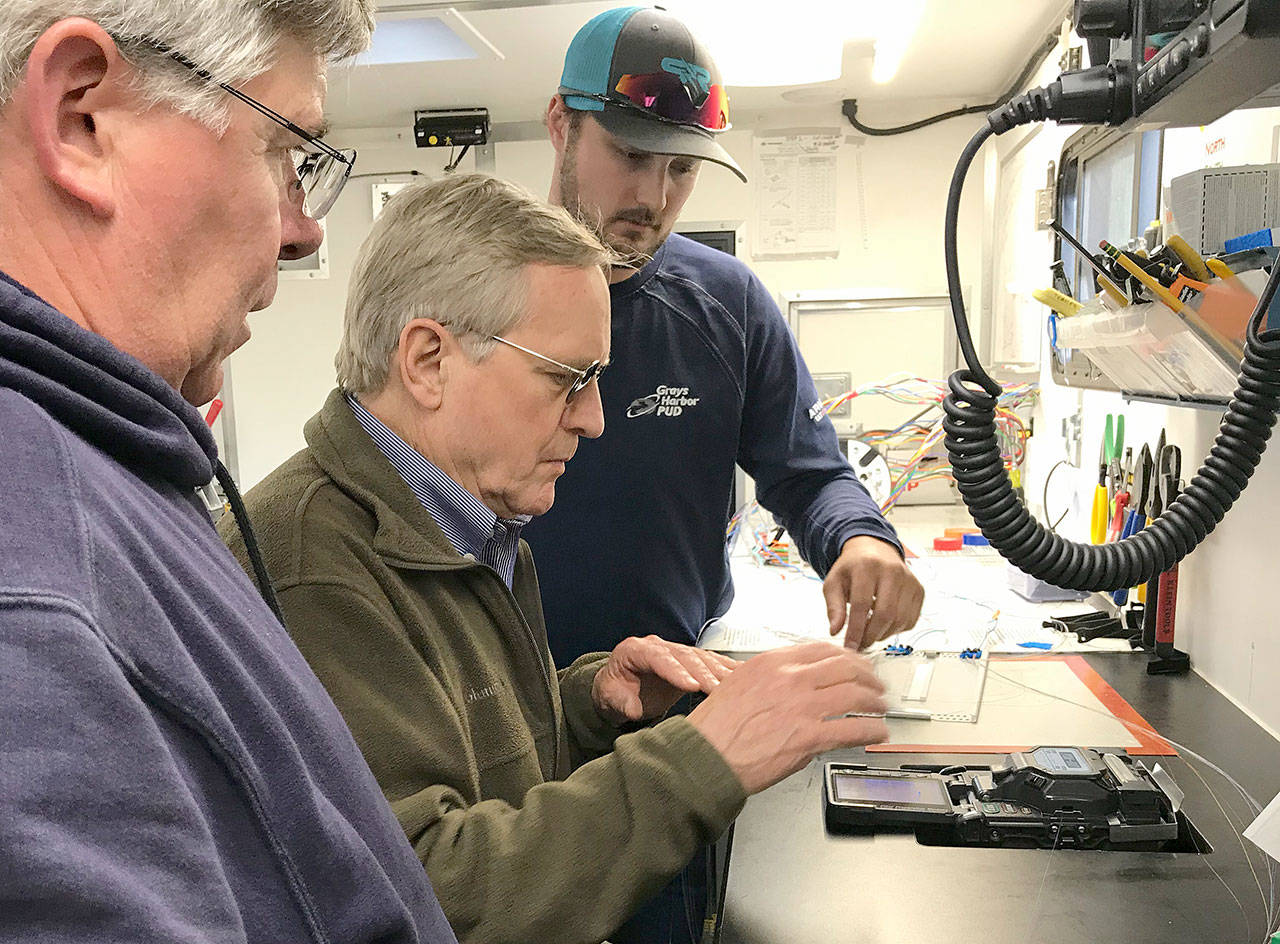Grays Harbor, and East County in particular, are making up ground on the rest of the nation in terms of access to broadband internet.
Last week, two events showed just how much progress recently has been made.
Grays Harbor Public Utilities District celebrated the completion of what they call the East County Fiber project. And U.S. Rep. Derek Kilmer (D-Gig Harbor) met will community leaders to discuss his Broadband for All Act.
East County Fiber
At a public relations event outside Elma School District offices, PUD personnel made the final connections on fiber optic lines that will connect two of the last school districts directly to high-speed internet, a vital resource when many of the state mandated tests are performed online.
“This is a big deal for the community and the Grays Harbor PUD,” agency Core Services Director Rob Hanny said of the East County Fiber project in a release. “In addition to providing options for new services and new service providers in the community, this project will improve the availability of broadband services for the Elma and Satsop school districts and businesses.”
Two districts in the county remain unconnected to the PUD fiber optic lines: Oakville and Lake Quinault.
“It’s like rural electrification was in the ’30s. It’s just become a fundamental infrastructure,” state Rep. Steve Tharinger said, comparing recent efforts to bring broadband to rural communities to the federal funding to bring electrical power to similar areas in the 1936 Rural Electrification Act. “Education, health care, economic development, there’s just so much that’s dependent on having that capacity.”
Kevin Acuff, superintendent at the Elma School District said the new fiber options could provide cost savings in the future.
“Right now, we are not using that connection because we have a signed contract with the K-20 network that has served us for many years,” Acuff wrote in an email. “What this new fiber will do for us in the coming years may save us a significant amount of money. Each year, we negotiate with our service providers. Prior to this feed being created, we had no options except for our existing network. This will allow us to pursue a contract with more providers, which may well result in significant cost reductions.”
During the 2017-2018 legislative session, Rep. Mike Chapman requested $463,000 in state funding for the project, which was approved.
“This will work for small business to grow and relocate,” Chapman said. “(Without modern communications services,) you’re trying to grow the economy with one arm tied behind your back.”
Schools and businesses are expected to benefit from the new fiber optic lines.
Tim Martin, president of Harbor Pacific, attended Thursday’s event in Elma. In addition to its soda distribution business, Harbor Pacific provides drinks and snacks to vending services and “micromarkets,” Martin said. Many of his orders are placed and filled electronically.
“We’ve had issues in the past where the internet will go down and now we’re back to paper. And our productivity goes down, and our accuracy is not as good,” he said. “It’s just an infrastructure that’s indispensable for our business, as it is for many businesses these days.”
Broadband for All
But having the PUD wires connected to hubs across the county is not enough. That’s where Rep. Kilmer come in. His Broadband for All bill would provide a refundable tax credit for home- and business owners to bring the infrastructure to their buildings.
“In a district like mine, where we’re in the bottom 20 percent in terms of access to high-speed internet, you chip away at a big chunk of that if you’re able to get at that last mile,” Kilmer said Friday at a meeting with civic, business and community leaders.
That “last mile” is the void Kilmer hopes to fill. He hopes his bill would become part of any larger infrastructure bill being talked about in the nation’s capital.
Kilmer’s bill would provide a tax refund of 75 cents per dollar of investment made to install that last mile of communications infrastructure.
“If there is discussion of a one or two trillion dollar in infrastructure package, I think having a component that focuses on access to internet, including some of these last mile issues, is entirely appropriate,” he said.
Many homes and businesses are blocks away from the high-speed internet lines, but the last mile becomes an investment most communications companies are unwilling to make because of the lack of return.
Hanny, the PUD core services direct, said a recent bid to place 200 feet of wire underground to connect one house was about $6,000 and a mile of overhead fiber optic line on poles costs about $30,000. Companies do not get that return on investment from a $40 per month internet service contract.
“Where rural America gets hosed on is because we don’t have density,” Kilmer said. “When you’re within spittin’ distance of being able to connect to that pipe, that’s what we’re trying to solve for.”



